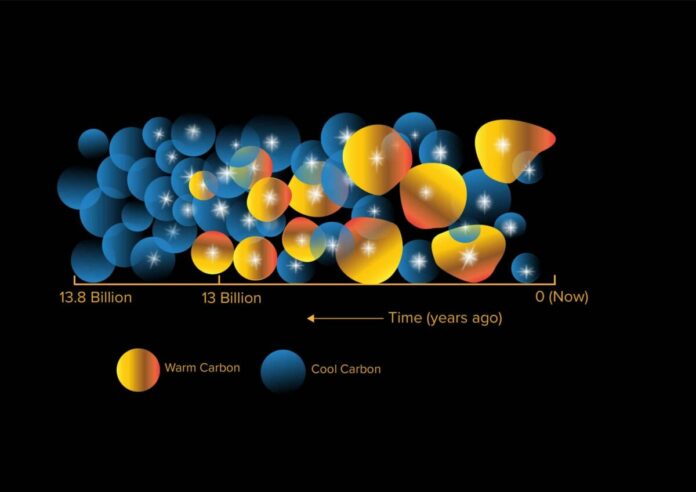A new study by Astrophysicists in Australia adds yet another piece to the Universe’s history puzzle. By measuring the density of carbon in the gases surrounding ancient galaxies, the team shed new light on the state of the Universe 13 billion years ago.
They discovered that the carbon content of warm gas rose quickly around 13 billion years ago, which may have been caused by extensive gas heating brought on by the “Epoch of Reionization” phenomenon. This suggests that warm carbon suddenly increased by 5x over only 300 million years – the blink of an eye in astronomical timescales.
Dr. Rebecca Davies, ASTRO 3D Postdoctoral Research Associate at Swinburne University of Technology, Australia, and lead author of the paper describing the discovery, said, “That’s what we’ve done here. And so, we present two potential interpretations of this rapid evolution. The first is that there is an initial increase in carbon around galaxies simply because there is more carbon in the Universe.”
“During the period when the first stars and galaxies are forming, a lot of heavy elements are forming because we never had carbon before we had stars. And so one possible reason for this rapid rise is that we’re seeing the products of the first generations of stars.”
After the Big Bang’s cosmological Dark Ages, the lights were turned back on at the Epoch of Reionisation, when the Universe was “only” one billion years old.
The cosmos was previously covered in a thick, dark gaseous fog. The Universe, however, was reionized as the first massive stars started to form, and their light began to shine through space. This light may have caused the surrounding gas to heat up quickly, which is what caused the increase in warm carbon that was seen in this research.
To comprehend when and how the first stars formed and started creating the elements that are present today, studies of reionization are essential. However, observations have a history of being challenging.
Dr. Valentina D’Odorico from the Italian Institute for Astrophysics, the Principal Investigator of the observational programme, said, “The research led by Dr. Davies was built on an exceptional sample of data obtained during 250 hours of observations on the Very Large Telescope (VLT) at the European Southern Observatory in Chile. This is the largest amount of observing time assigned to a single project with the X-Shooter spectrograph.”
“Thanks to the 8m VLT we could observe some of the most distant quasars, which act as flashlights, illuminating galaxies along the path from the early Universe to the Earth.”
Some photons are absorbed by galaxies during the quasar light’s 13 billion-year voyage across the Universe, leaving behind unique barcode-like patterns in the light that can be analyzed to learn the chemical makeup and temperature of the gas in the galaxies.
This paints a picture of the Universe’s historical evolution.
Dr. Davies explains, “These ‘barcodes’ are captured by detectors at the VLT’s X-Shooter spectrograph. This instrument splits the galaxy light into different wavelengths, like putting light through a prism, allowing us to read the barcodes and measure the properties of each galaxy.”
The study captured more barcodes of ancient galaxies than ever before.
Dr. D’Odorico said, “We increased from 12 to 42 the number of quasars for which we had high-quality data, finally allowing a detailed and accurate measurement of the evolution of the carbon density. This major advance was enabled by the ESO VLT, one of the most advanced telescopes on Earth and a strategic partner of Australia.”
Professor Emma Ryan-Weber, a Chief Investigator in the ARC Centre of Excellence for All Sky Astrophysics in 3 Dimensions (ASTRO 3D) and second author of the study, said, “The study provides a legacy data set which will not be significantly improved until 30m-class telescopes come online towards the end of this decade. High-quality data from even earlier in the Universe will require access to telescopes like the Extremely Large Telescope (ELT) now under construction in Chile.”
“Our results are consistent with recent studies showing that the amount of neutral hydrogen in intergalactic space decreases rapidly around the same time,” says Dr. Davies.
“This research also paves the way for future investigations with the Square Kilometre Array (SKA), which aims to directly detect emission from neutral hydrogen during this key phase of the universe’s history.”
Professor Ryan-Weber says the research goes to the heart of ASTRO 3D’s mission to understand the evolution of elements from the Big Bang to the present day.
“It addresses this key goal: how did the building blocks of life – in this case, carbon – proliferate across the Universe?
“Humans strive to understand ‘where did we come from?’ It’s incredible to think that the barcode of those 13-billion-year-old carbon atoms were imprinted on photons when the Earth didn’t even exist. Those photons traveled across the Universe, into the VLT, and then were used to develop a picture of the evolution of the Universe.”
Journal Reference:
- Rebecca Davies et al. Examining the decline in the C IV content of the Universe over 4.3 ≲ z ≲ 6.3 using the E-XQR-30 sample. Monthly Notices of the Royal Astronomical Society, Volume 521, Issue 1, May 2023, Pages 314–331, DOI: 10.1093/mnras/stad294
